Hey there, fellow garden enthusiasts! Do you have a sloped area of your yard that you’ve struggled with landscaping? For the past seven years, Sterling and I have been slowly renovating our backyard and transforming it into various gardens both for growing vegetables and flowers. We’ve had such success getting our backyard to slowly flourish into something beautiful and satisfying. Yet there has been one area right behind our garage that has been such a huge eye sore throughout all of the summers landscaping our outdoor space. This area is on a very small hill that slopes down away from the garage and into the rest of the backyard.
Deciding to Landscape our Sloped Yard
When we moved in, there was hardly any lawn growing in this space, so we tried planting sod to improve the look of the lawn. To our dismay, the sod didn’t look great for very long. We learned that in Denver’s very dry climate, keeping new lawn alive without a sprinkler system was going to be a tough undertaking. Before long, the grass dwindled and the weeds overtook our hard work right back to where it was when we started.
We finally gave up on growing grass in this area. It isn’t easy mowing lawn on a hill anyway, so there were benefits to getting rid of the lawn here! Therefore, we started a gradual plan of planting some drought tolerant plants in this space. You can read about how we created our first low water requiring flower bed behind the garage in this post. It was a good first “go” at taking this in the right direction. But it needed more effort and a larger, more intentional plan.
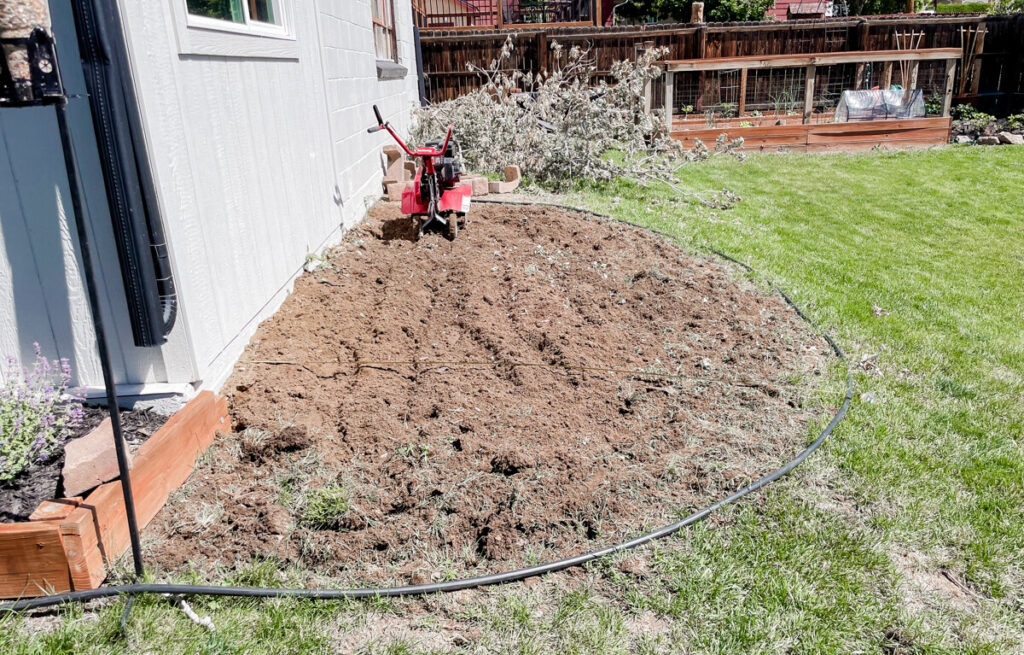
By the following year, I got my husband, Sterling, on board to help me expand this space and create my true vision of what it could become. With his construction knowledge and my creative gardening brain, we got to work. It was about a 6 month project (we took our time!) but we did all the labor ourselves. We learned a few things along the way and have put together this guide for what to consider when landscaping a sloped yard. It can seem like a daunting task, but with the right approach and a sprinkle of creativity, you can turn that tricky terrain into something that works so much better.
1. Embrace the Natural Flow
First things first, don’t fight the slope – embrace it! Your yard’s natural contours can be your best friend. Work with the slope’s direction and use it to your advantage. We knew this area behind our garage was the natural walking pathway to our vegetable garden. We cut right across every time we walked out to the yard to pick veggies. Leveling it out to provide an actual walking path felt like a good start to our plan. Not to mention, more flat space would provide some extra planting area. We decided to create a retaining wall that followed the slope and also connected this new bed to the existing vegetable garden. Embracing the flow of what’s already existing and building off of it can give your yard a harmonious and organic feel.
2. Plan Your Sloped Landscape Design
Landscape design always begins with a plan of some sort. Simply sketch out your ideas on paper or use digital tools to visualize your vision. Collect ideas on Pinterest and become inspired for things to add and include. Part of figuring out how to landscape a sloped yard involves mapping out paths, seating areas, and focal points to make your sloped yard both functional and beautiful.
We knew we wanted to include a hot tub in our new landscaping plan for our sloped yard. So we sketched out how that might look in a certain spot, where plantings might go around it, and where pathways might be to move you through the garden.
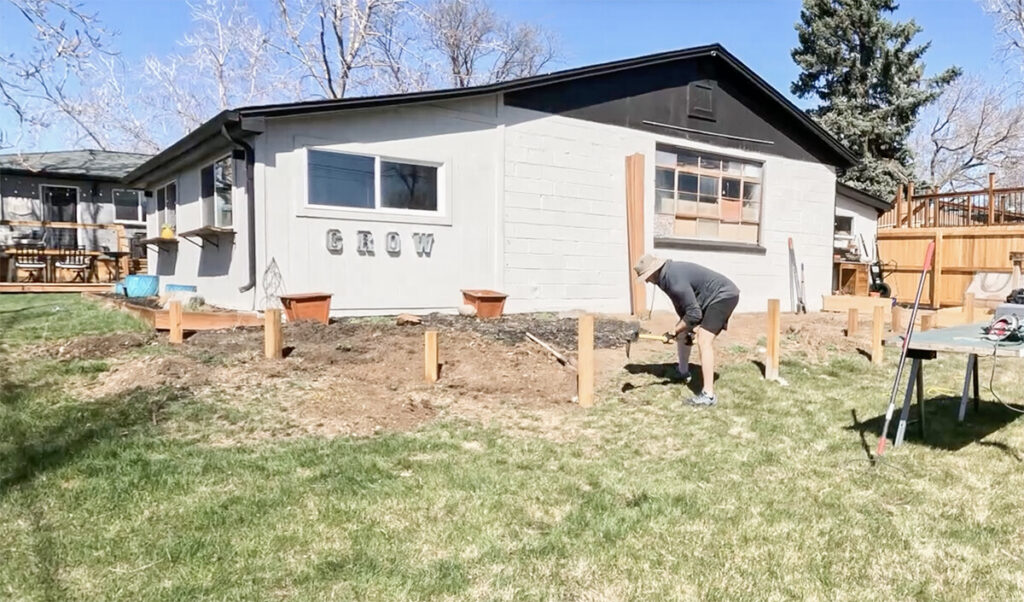
3. Build Retaining Walls
Retaining walls are your secret weapon when landscaping a sloped yard. They provide structural support, help prevent soil erosion, and can be aesthetically pleasing. You can opt for various materials like stone, wood, or concrete blocks to match your preferred style. Use these walls to create distinct levels, planters, or even seating platforms.
Since our sloped yard wasn’t very steep, our retaining wall didn’t need to be very high. But it needed to be tall enough to level out some of the dirt in this new garden bed. Sterling poured cement into holes for our posts, then attached pressure treated wood to them as our retaining wall. We began moving the dirt away from the garage towards the retaining wall he had built until the area was level. Much to our surprise, we didn’t need to add extra fill dirt. We had just enough dirt just by moving what was there until the area was level.
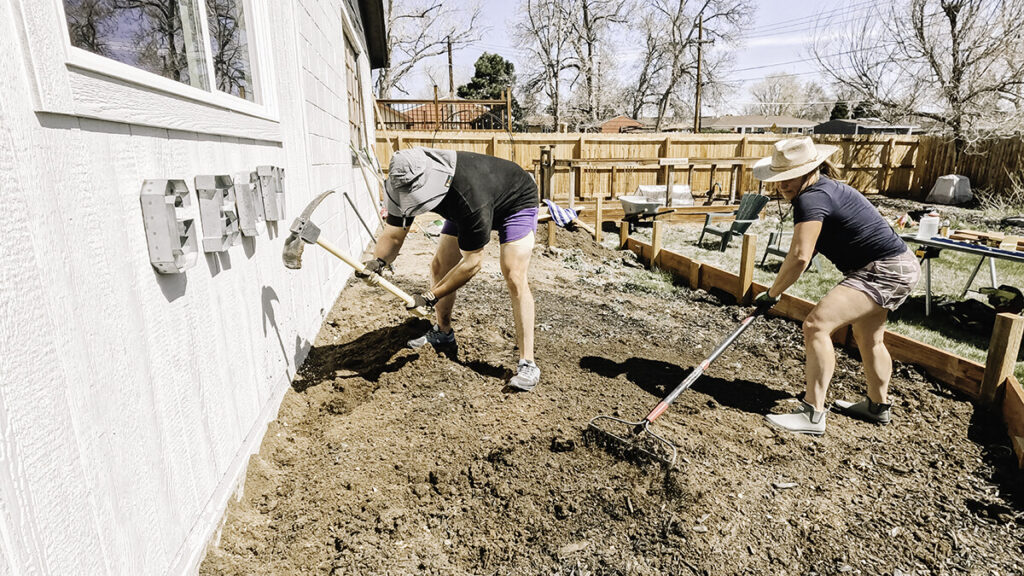
4. Plant Selection Matters
Choosing the right plants when landscaping a sloped yard is an important step. For us, it was a crucial part of the process because the entire reason for reworking this space was to not only create a visually interesting garden (versus a lawn that didn’t grow), but also to reduce the amount of water we needed to keep the area alive. A garden with native, drought tolerant plants was going to be the key to our success in revamping this space.
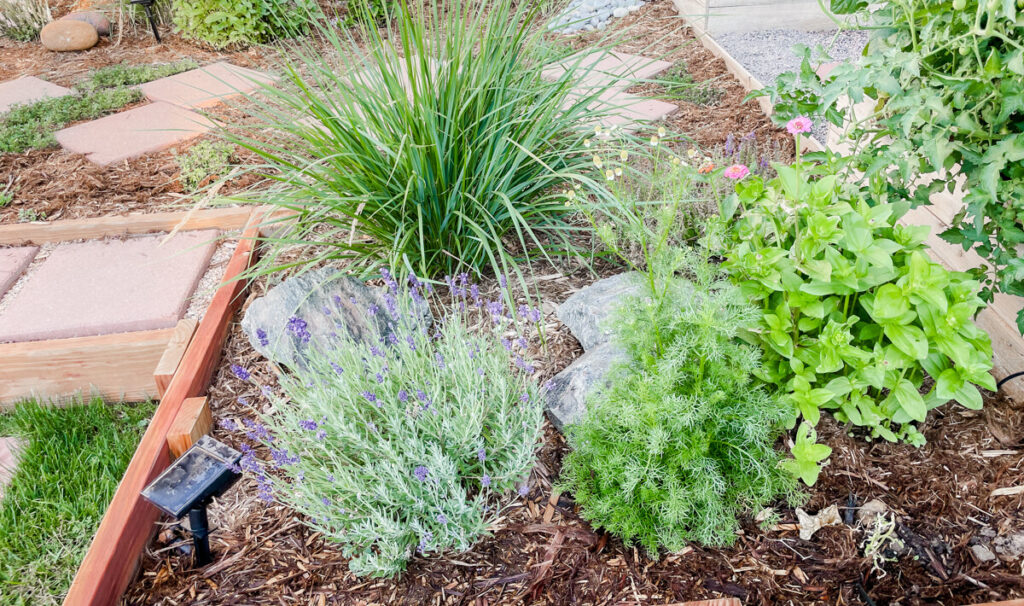
I knew I wanted native, perennial plants of various heights that bloomed in different colors. Many that I chose were drought tolerant and perfect for this hot, sunny location with over 6 hours of daily sun. Groundcovers like pink creeping thyme were planted in between stepping stones in the walkway. Ornamental grasses were added along with a handful of flowering annual flowers like zinnias. I even added a few medicinal herb perennials like lavender and german chamomile. Come Fall, I could have some fun experimenting with homemade concoctions like chamomile tea and lavender body butter.
For us, the most exciting last minute addition to this garden bed were the four, Frontenac wine grape plants we made space for as the retaining wall went up. Not part of the original landscaping plan, this idea came once we saw the garden bed walls go up. Sterling and I have always wanting to try our hand at growing wine grapes. Up against the edge of the retaining wall seemed like the perfect space for them as they would eventually edge our hot tub area. It not only would add a little bit of extra privacy, but the growing vines would also be fun for us to look at while relaxing in our hot tub.
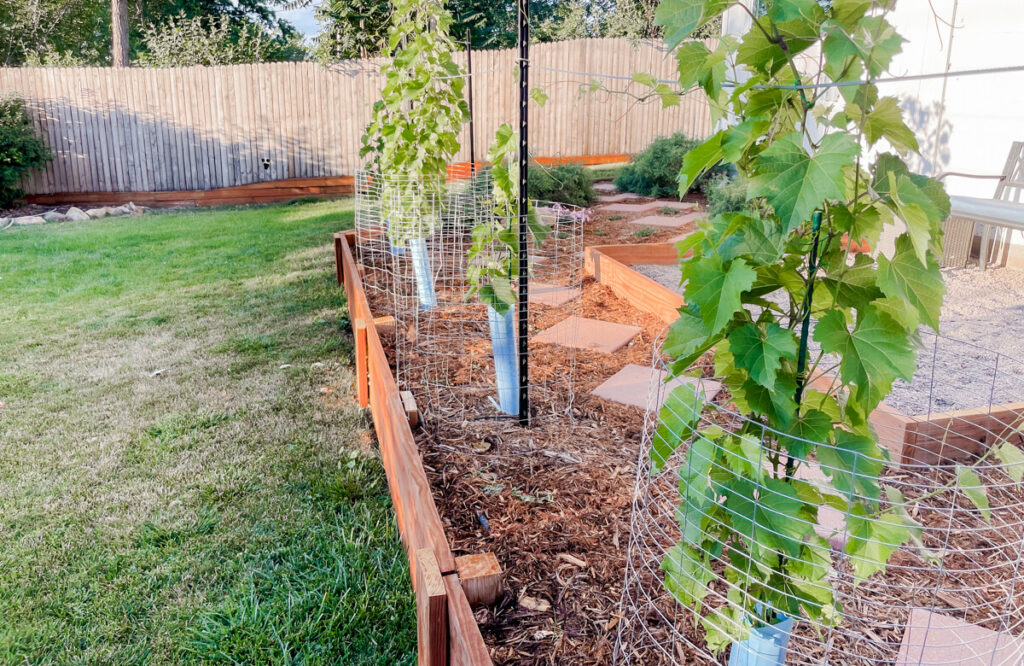
5. Create Visual Interest
A sloped yard offers an opportunity to unleash your creative flair. It’s a space where you can infuse your personality through carefully chosen elements that catch the eye and create visual interest. Imagine a water feature or the intriguing interplay of light and shadow on a thoughtfully placed sculpture. The incline of your yard presents a chance to experiment with unique plantings that cascade down the slope. If the hill in your yard is long enough, consider adding levels within the retaining walls, with possibly a few steps running through the center.
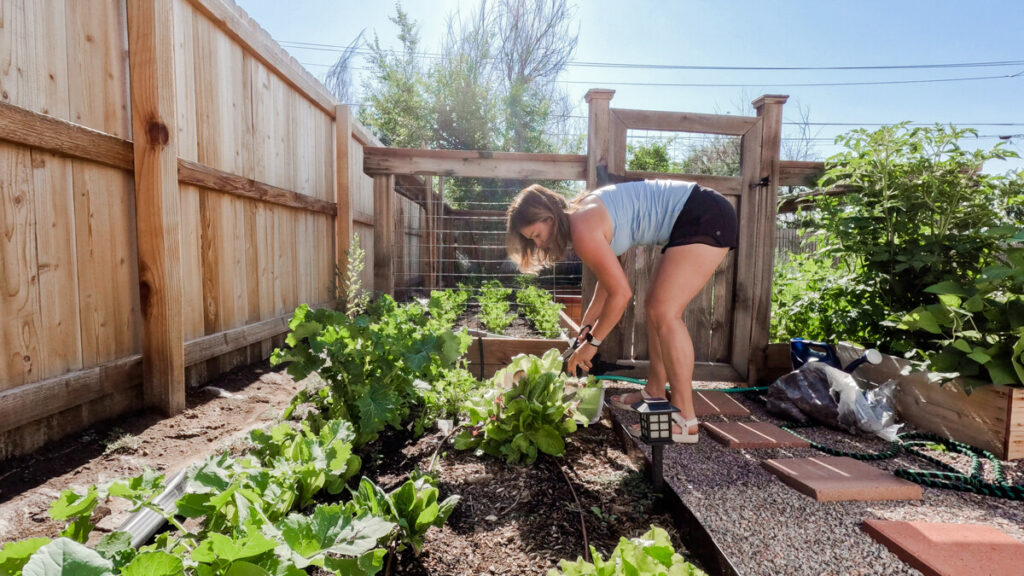
As we mapped out the landscape design for our area, I held a vision of a seamless transition between my enclosed vegetable garden and the surrounding garden bed. We extended the planting area from my fenced-in raised beds over to the side of the garage. This gave us additional room to plant lettuce and greens and also created an opportunity to add some visual interest. We introduced two more raised garden boxes, thoughtfully linked by an elegant archway. Pea gravel and stepping stones were added as a continuation of the path throughout the space. This delightful archway is where I grow my vining green beans every year. It now serves as a welcoming gateway, inviting us from the main garden bed into my vegetable-growing area.
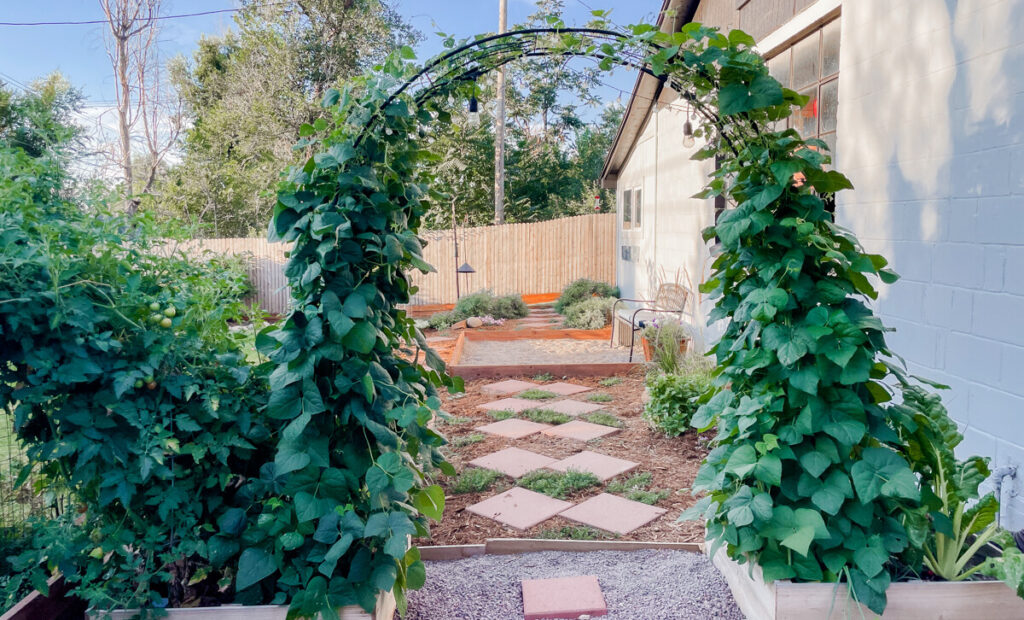
6. Mindful Pathways
When learning how to landscape a sloped yard, it’s imperative to pay careful attention to the creation of thoughtfully designed pathways. These pathways act as the connective threads that weave your outdoor space together, enhancing both accessibility and aesthetics. Imagine the charm of meandering along a winding trail of smooth stepping stones, each one guiding you through the landscape.
Since we were adding a hot tub here when landscaping our sloped yard, we knew we needed a pathway if for nothing more than to access the hot tub. But since this was also the general route we took to our vegetable garden, we wanted to place stepping stones throughout the entire space. We love a good repurposed find for our garden and were able to find all of our pavers (for free!) on Facebook Marketplace. This saved us significant cost on materials when renovating this space. So get creative when planning out your garden and it may save you money!
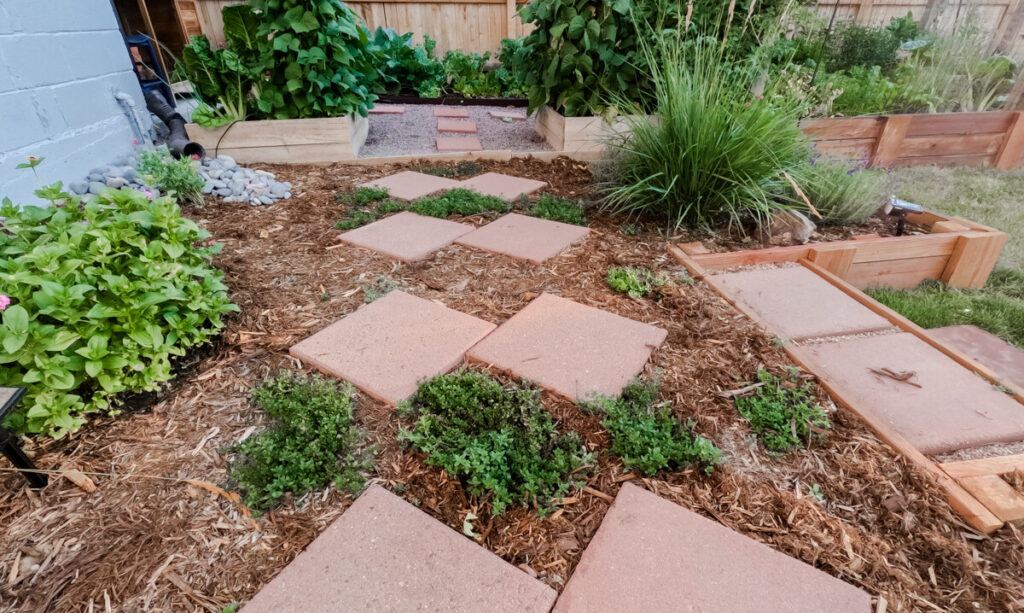
7. Lighting Magic
Outdoor lighting can work wonders in a sloped yard. Well-placed lights not only enhance the aesthetics but also provide safety and ambiance. Use uplights to highlight plants or retaining walls. Pathways are also opportunities to add garden lighting to ensure they are well-lit in the evening. Strategically placed lights add a magical ambiance that transforms your garden into an inviting space after dark.
8. Maintenance Made Easy
As with any garden, maintenance is key. Opt for low-maintenance plants and solutions that align with your lifestyle. Mulching can help retain soil moisture and prevent weed growth, saving you time and effort in the long run.
This was imperative for us when planning this area. One of the biggest reasons for transforming this outdoor space was to eliminate all the weed growth that occurred behind the garage. So we carefully mulched the area. We even tried portion of the bed using cardboard underneath the mulch to keep weeds at bay.
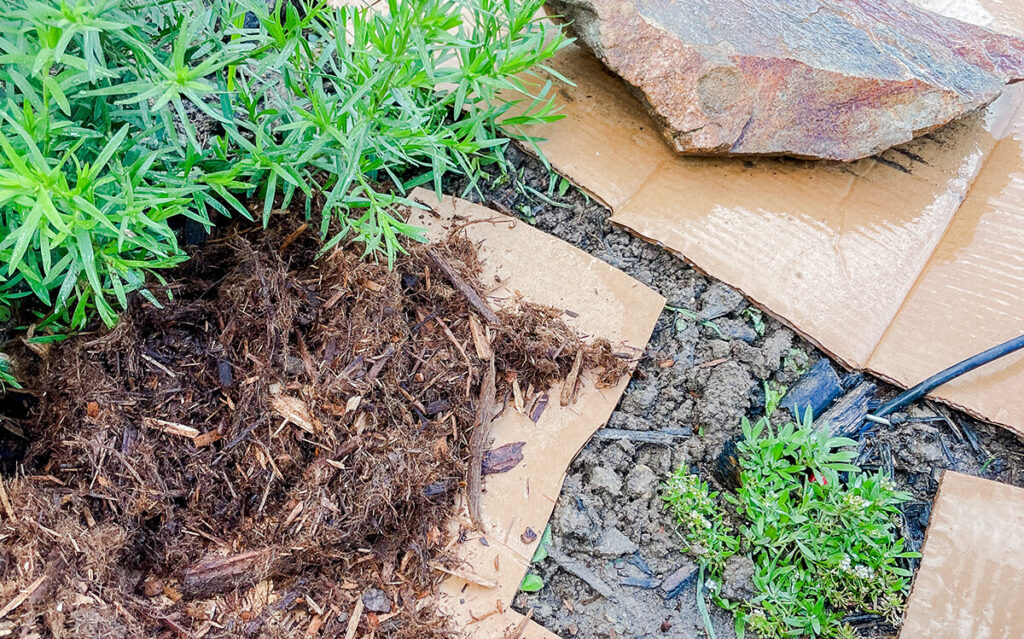
Conclusion: Your Personal Sloped Haven
Landscape a sloped yard might seem challenging at first, but armed with a solid plan and a dash of creativity, you can transform that tricky terrain into a personal paradise. Embrace the slope, choose your plants wisely, and design with purpose. Remember, there’s no one-size-fits-all solution, so let your unique style shine through.
So, gear up and let your imagination run wild! Your sloped yard could soon become the envy of the neighborhood, a testament to your dedication and gardening prowess. Happy landscaping!





